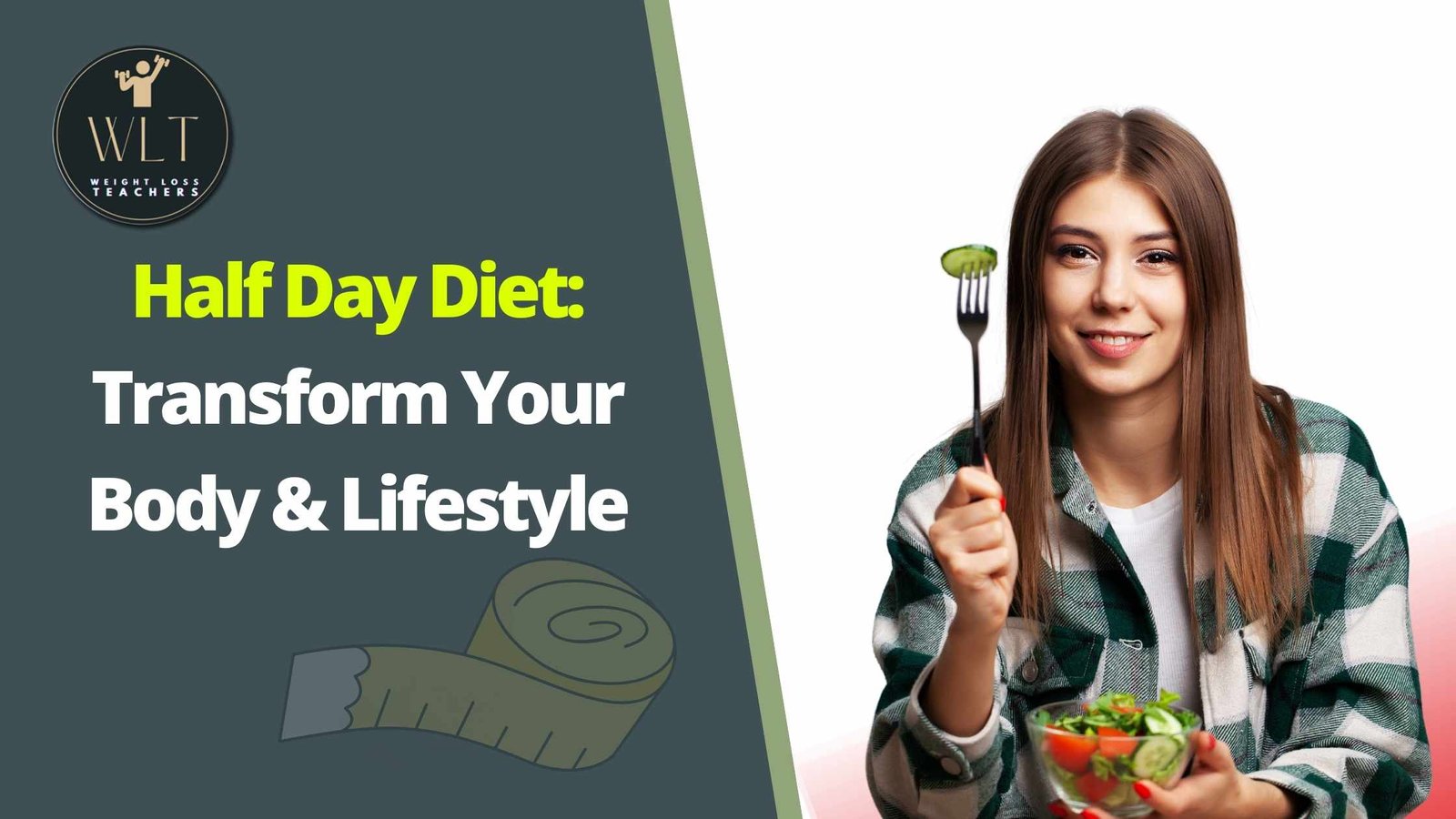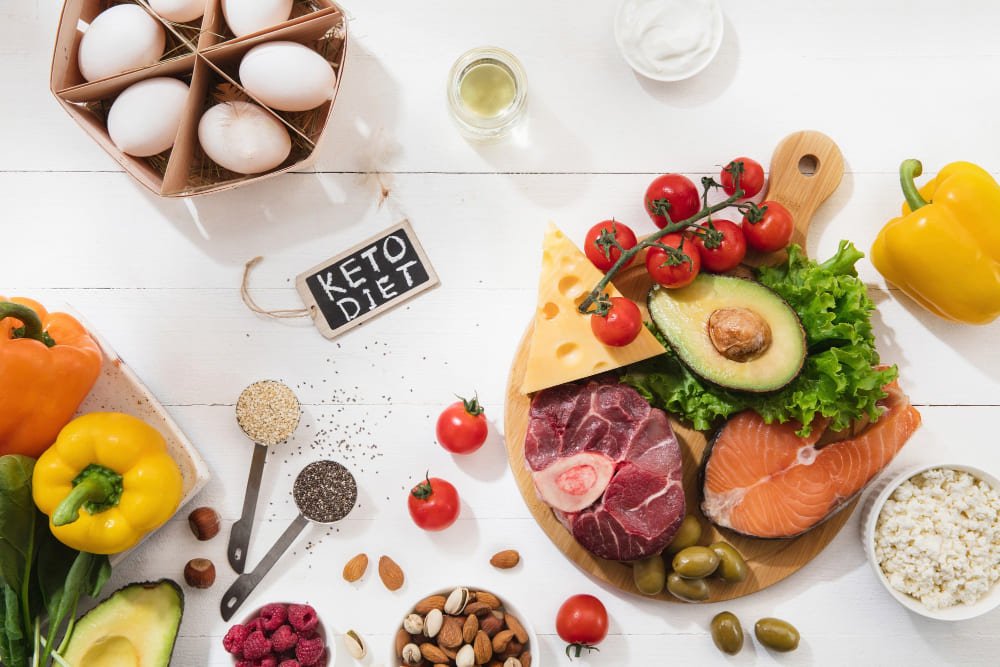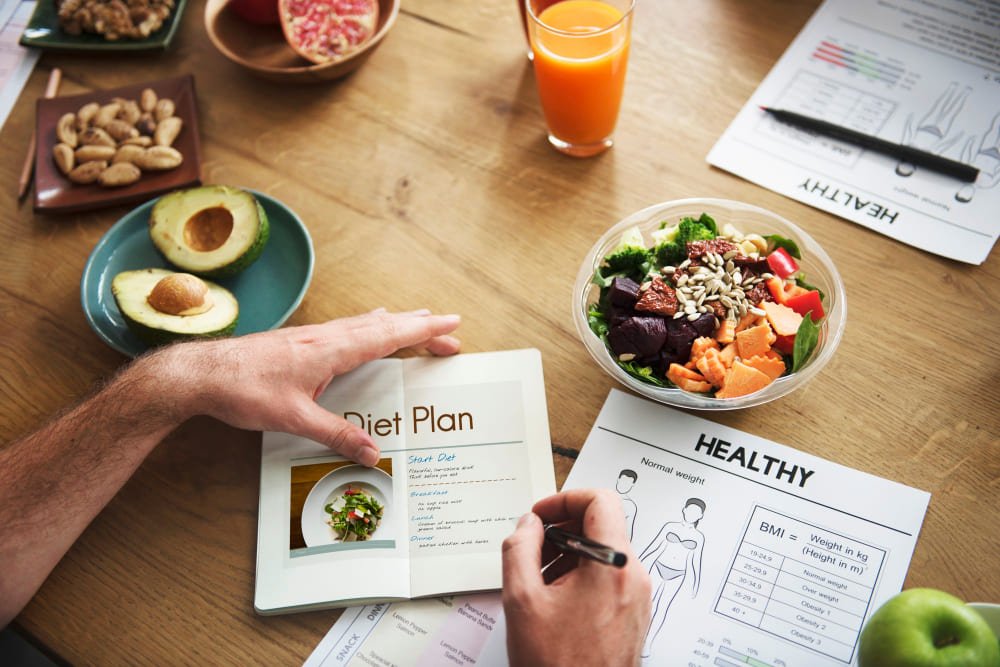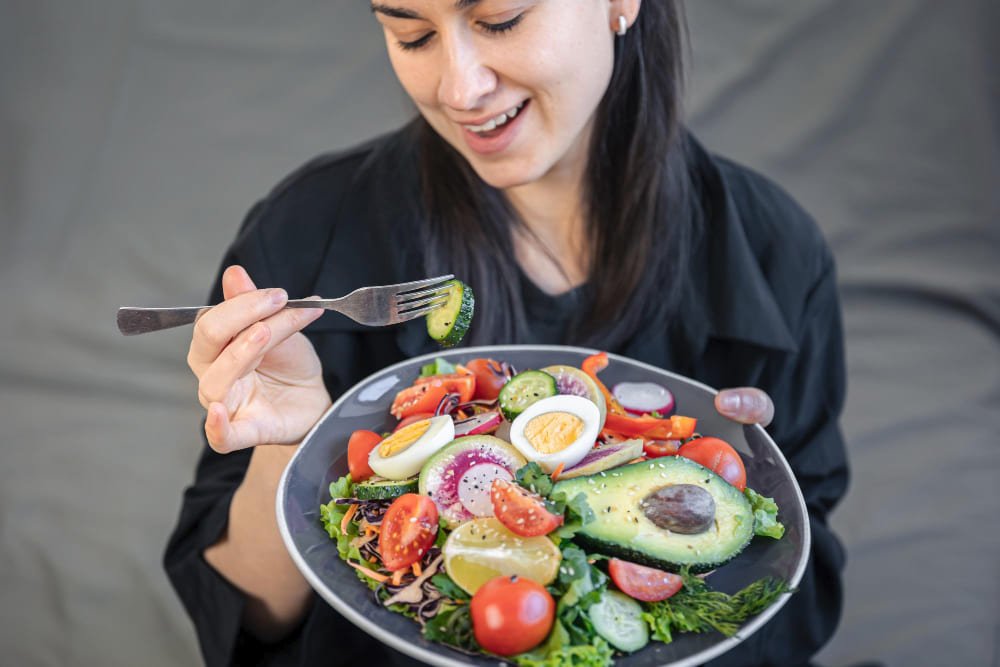
Half Day Diet: Transform Your Body & Lifestyle

Did you know nearly 70% of American adults are overweight or obese? This shows we really need good weight loss plans and healthy eating. The Half Day Diet is a new way to eat, created by expert Nate Miyaki. It lets you enjoy carbs at night but eat nutrient-rich foods during the day.
This diet is why so many people are excited to try it. They want to change their bodies and live healthier. Let’s explore how the Half Day Diet works, its benefits, and how to use it. We’ll help you on your path to being healthier and happier.
Table of Contents
What is the Half Day Diet?

The Half Day Diet is a unique way to eat. It focuses on eating the right amounts of food at the right times. You eat high-protein and green foods during the day. Then, you can have more carbs in the evening.
This diet is based on how our ancestors ate. It was created by Nate Miyaki, a San Francisco bodybuilder. It’s a new way to eat that’s different from old low-carb diets.
Overview of the Concept
The Half Day Diet has three main parts for losing weight. You eat carbs mostly at night. This helps you feel full and gives you energy during the day.
You eat lean proteins and veggies during the day. This fits with today’s healthy eating trends. Studies show it helps people lose weight better than eating carbs all day.
Origin and Popularity
Nate Miyaki made the Half Day Diet. It’s become popular because it’s a healthy way to lose weight. It’s different from other diets that are too strict.
A study in 2011 in the Obesity Journal showed it works. The diet fits into many lifestyles. It’s liked by people in the US who care about their health.
Health Benefits of the Half Day Diet

The Half Day Diet has many health benefits. It fits with what science says about eating right. It helps people lose weight and improve their metabolic health.
Scientific Studies Supporting Its Efficacy
Studies show the Half Day Diet is good for you. People who try it lose more fat than those on regular diets. They also do better with their weight.
A study found that eating carbs at certain times helps with weight control. This shows the diet works well for keeping weight off and eating healthy.
Boosting Metabolism
The Half Day Diet helps your metabolism. It limits calories at certain times. This makes your body use fat for energy.
It makes your metabolism work better. You stay full of energy all day. This helps you lose weight and stay healthy.
Role in Weight Loss
This diet helps people lose weight. It lets you eat carbs in the evening. This helps control cravings and binge eating.
People feel full and balanced. They meet their calorie goals. This makes losing weight feel good and lasting.
How Does the Half Day Diet Work?

The Half Day Diet uses a special way of eating. It focuses on macronutrients and meal timing. This helps people use energy better and burn fat by controlling when they eat carbs.
Mechanisms of Action Explained
The diet’s main idea is to eat low-carb meals in the morning. This keeps blood sugar steady and boosts fat burning. Then, you can eat more carbs in the evening.
This plan fits with our natural body rhythms. It helps use energy well and cuts down on fat storage.
Importance of Meal Timing
Meal timing is key to the Half Day Diet’s success. Eating carbs in the evening boosts energy use and metabolism. Eating nutrient-rich foods like fruits, veggies, and lean proteins during low-carb times is smart.
This makes the diet easy to follow and keeps you from feeling too hungry or restricted.
| Dieting Strategy Element | Description |
|---|---|
| Low-Carb Meals | Focus on protein and vegetables during the first half of the day. |
| Carbohydrate Timing | Consume higher carbs in the evening to maximize energy. |
| Macronutrient Balance | Prioritize lean proteins and healthy fats to support weight loss. |
| Personalization | Select meal timing based on individual lifestyle and preferences. |
Recommended Dosage for Men and Women

Knowing what you need to eat is key to getting the most from the Half Day Diet. The right amount depends on your weight and age. This helps with weight control and boosts health. Here are the tips for both men and women to follow this diet well.
Dosage Guidelines by Weight and Age
How many calories you need changes with age and sex. Women usually need 1,600 to 2,400 calories a day. Men often need 2,000 to 3,000 calories.
Basal metabolic rate (BMR) is also important. Women’s BMR is 1,400 to 1,500 calories daily. Men’s BMR is 1,600 to 1,800 calories. Knowing these helps make a diet plan that fits your goals.
Key factors to consider include:
- Age: Metabolism slows with age, often requiring fewer calories.
- Activity Level: More active individuals may necessitate higher caloric intake.
Adjustments for Active Lifestyles
If you’re very active, you might need more calories. Adding healthy fats and snacks can help. This way, you get the calories you need.
These changes help athletes and active people get the right nutrition. Here are some tips:
- Increase protein intake: Add an extra serving of lean meat or plant-based protein to your evening meals.
- Portion sizes: Change your portion sizes at night if you’re very active.
- Healthy fats: Eat more healthy fats like avocados, nuts, and olive oil. This way, you get enough calories without too much processed food.
By following these guidelines and making these adjustments, you can manage your weight well. It also supports your active lifestyle.
Potential Side Effects
The Half Day Diet works well for many people. But, it’s important to know the side effects of fasting and changing diets. Knowing these can help you adjust easier.
Common Side Effects to Be Aware Of
When starting the Half Day Diet, you might feel:
- Hunger pangs as your body gets used to fasting
- Short-term fatigue when you change your eating times
- Gastrointestinal discomfort as your stomach adjusts
It’s key to know these side effects to handle diet risks well. Drinking enough water while fasting can also help avoid some health problems.
Rare but Serious Side Effects
Some people might face rare but serious issues from quick diet changes. A big worry is nutrient deficiencies or electrolyte imbalances. This is especially true for those fasting often without help.
These serious side effects show why watching your health is so important. This is especially true for people with health problems or those on medication.
In short, being aware and watching your health can make the Half Day Diet better. Knowing about side effects and health risks helps you do well on your diet journey.
Note: There might be affiliate links mentioned here. We may receive a commission if you purchase a product through an affiliate link. There is no additional charge for you. Please do your own research before making any online purchases.
Precautions to Consider

Starting the Half Day Diet is exciting, but it’s important to know the dietary precautions and health considerations. This diet works for many, but it might not be right for everyone, especially those with health issues.
Who Should Avoid the Half Day Diet?
Some people should not try the Half Day Diet. Those with diabetes or eating disorders should talk to a doctor first. Pregnant or breastfeeding women also need to be careful because their bodies have different needs.
Getting advice tailored to you can help make the diet safer and more effective.
Tips for Safe Implementation
Starting the Half Day Diet can be good for your health if you do it carefully. Here are some tips to help you:
- Gradual introduction: Start with simple meals from whole foods to get used to the new diet.
- Focus on hydration: Drink lots of water during fasting times to stay hydrated and healthy.
- Monitor mood and energy: Watch how your mood and energy change. Adjust your diet if needed.
By following these tips, you can make the Half Day Diet a part of a healthier lifestyle. Paying attention to your own needs makes the journey smoother and more successful.
Natural Sources and Foods to Include
A balanced Half Day Diet needs a mix of natural foods for healthy eating. Eating a variety of foods makes meals more enjoyable. It also makes sure you get all the nutrients you need.
Recommended Foods for the Half Day Diet
- Lean Proteins: Chicken, fish, and legumes (beans and lentils) are great for muscles and health.
- Complex Carbohydrates: Whole grains like quinoa, brown rice, and whole-wheat pasta give energy and nutrients.
- Colorful Vegetables: Spinach, broccoli, and colorful veggies are full of vitamins and minerals for a strong immune system.
- Nutritious Fruits: Eating different fruits, like berries and citrus, adds antioxidants and fiber.
- Healthy Fats: Oils like olive and canola make meals better and cut down on bad fats.
Nutritional Benefits of Each Food
| Food Type | Nutritional Benefits |
|---|---|
| Lean Proteins | Helps muscles grow and repair; boosts metabolism. |
| Whole Grains | Gives lasting energy and fiber for a healthy gut. |
| Vegetables | Full of vitamins, minerals, and antioxidants; helps with weight control. |
| Fruits | Has important nutrients; boosts mood and energy. |
| Healthy Fats | Good for heart health; helps absorb nutrients. |
These natural foods are key to a strong and balanced diet. Adding them to your meals makes eating fun. It also helps keep you healthy for a long time.
Delicious Recipes for the Half Day Diet
Delightful and nutritious recipes are key to the Half Day Diet. They make sure each meal is tasty and healthy. Starting with healthy breakfast recipes is important. Then, choosing good lunch and dinner options keeps the diet balanced.
Breakfast Ideas to Kickstart Your Day
Begin your day with foods high in protein and healthy fats. Here are a couple of great options:
- Greek Yogurt with Berries: Greek yogurt with fresh berries and nuts is full of nutrients. It’s perfect for your morning.
- Vegetable Omelet with Avocado: Eggs, colorful veggies, and avocado make a filling, healthy meal. It’s great for energy.
Lunch and Dinner Combinations
Keep the diet going with nutrient-rich meals. These meals follow the Half Day Diet’s principles:
- Lunch: A fresh salad with lean proteins and legumes is a good choice. A Chicken Quinoa Bowl is a great option, offering a balanced meal.
- Dinner: Enjoy grilled salmon with sweet potatoes or whole-grain pasta with tomato sauce. These meals are flavorful and healthy.
These meals are made to satisfy your hunger and support a healthy lifestyle.
Best Products for Supporting the Half Day Diet
For those on the Half Day Diet, top-rated dietary supplements can help. Quality health products are key for nutrition support. They help you meet your dietary goals.
Top-rated Supplements and Ingredients
Some effective dietary supplements to consider are:
- Whey protein: A convenient source of protein that helps build muscle and supports weight loss.
- Omega-3 fatty acids: Beneficial for heart health, these can also aid in reducing inflammation associated with various health conditions.
- Multivitamins: Help bridge nutritional gaps, especially for those who may struggle to meet their needs through food alone.
Comparison of Cost and Benefits
Understanding the cost of these supplements is important. It helps you choose wisely. Here’s a table comparing popular options, their costs, and benefits:
| Supplement | Average Cost per Serving | Key Benefits |
|---|---|---|
| Whey Protein | $1.00 | Supports muscle recovery, aids in weight management |
| Omega-3 Fatty Acids | $0.75 | Promotes heart health, reduces inflammation |
| Multivitamins | $0.50 | Covers daily nutritional needs, boosts immunity |
Reading customer reviews and checking scientific evidence helps. This way, you can choose the right health products for the Half Day Diet. Each product has special benefits for those on the diet.
Customer Reviews and Ratings
The Half Day Diet has caught people’s attention for its simple approach. Users share their stories, showing how it helps them lose weight and feel better. They talk about having more energy and enjoying their favorite foods after eating mindfully.
User Feedback on Effectiveness
People who tried the Half Day Diet say it works well for losing weight. They share how it changed their bodies and lives. Some lost 5 to 210 pounds in a year, showing its power.
Testimonials from Success Stories
Stories from those who tried the Half Day Diet show a supportive community. They share their wins, tips, and stories of staying strong. These stories prove the diet’s worth and motivate others to try it.
| User Experience | Weight Loss Achieved | Energy Levels |
|---|---|---|
| Positive | 5-210 pounds | Increased |
| Supportive Community | Varies by User | Varies by User |
| Tips and Motivation Shared | Results Noted | Inspiring |
Portion Control and Meal Planning
To do well on the Half Day Diet, you need to know how to control portions and plan meals. Knowing how much to eat is key to managing your weight. Many people get confused about how much food they should eat at home and out.
Learning the right diet rules can help you eat better. It can make you feel better about food.
Guidelines for Meal Portion Sizes
Knowing the right serving sizes is the first step in portion control. Using measuring cups or guessing can help keep things balanced. Here are some tips:
- Use smaller dishes to help reduce the amount of food per serving.
- Section your plate: fill half with fruits and vegetables, one-quarter with proteins, and one-quarter with grains.
- Measure bowls and plates to understand their capacities for better portion adjustments.
- Consider drinking water before meals to aid in satiety and control calorie intake.
Sample Meal Plan for One Week
A weekly meal plan is important for reaching your diet goals. It makes cooking easier. Here’s a meal plan that follows the Half Day Diet, with balanced nutrients:
| Day | Breakfast | Lunch | Dinner | Snacks |
|---|---|---|---|---|
| Monday | Scrambled eggs with spinach | Quinoa salad with chickpeas | Grilled chicken with sweet potatoes | Greek yogurt |
| Tuesday | Oatmeal with berries | Turkey and avocado wrap | Baked salmon with broccoli | Almonds |
| Wednesday | Smoothie with banana and spinach | Lentil soup with whole grain bread | Turkey stir-fry with veggies | Cheddar cheese |
| Thursday | Chia pudding with fruit | Mixed green salad with grilled tofu | Stuffed peppers with rice | Hard-boiled eggs |
| Friday | Pancakes made with almond flour | Tuna salad with mixed greens | Beef and vegetable kebabs | Veggie sticks with hummus |
| Saturday | Overnight oats with nuts | Chicken Caesar salad | Pasta with marinara sauce and salad | Fruit salad |
| Sunday | Egg muffins with veggies | Quinoa and black bean bowl | Roasted lamb with asparagus | Rice cakes with peanut butter |
This meal plan shows the value of eating a variety of foods. Each meal has protein, fiber, and nutrients. Following a meal plan helps you plan better and control portions.
Compatibility with Other Diets
The Half Day Diet is great for those wanting to mix it with other diets. It’s key to know which diets work well together. This way, you can eat foods that are good for you and fit your lifestyle.
By combining diets like Paleo or Mediterranean with the Half Day Diet, you focus on eating whole foods. You also get healthy fats and a variety of nutrients. This makes it easy to follow different diets and still eat well.
Merging Half Day Diet with Popular Diet Plans
To mix the Half Day Diet with other diets, think about a few things:
- Whole food focus: Eat more fruits, veggies, and foods without added stuff.
- Protein sources: Mix lean proteins from different diets to keep you full and strong.
- Healthy fats: Add foods like avocados and nuts that are good for you.
- Carbohydrate integration: Use carbs wisely to keep your energy up.
Avoiding Dietary Conflicts
Knowing about food sensitivities and health issues is crucial with the Half Day Diet. Stay away from foods that might cause problems. Here are some tips to help:
- Identify trigger foods: Find out which foods make you feel bad.
- Keep a food diary: Write down what you eat to see if you react to anything.
- Consult with professionals: Talk to nutrition experts to make sure you’re doing it right.
| Diet Plan | Key Focus | Dietary Benefits |
|---|---|---|
| Paleo Diet | Whole foods, lean proteins, healthy fats | Helps with weight loss, balances energy, and boosts nutrients |
| Mediterranean Diet | Fruits, vegetables, whole grains, healthy fats | Good for heart health, lowers disease risk, and increases life span |
| Half Day Diet | Intermittent eating periods | Helps with weight, boosts metabolism, and improves body shape |
By using these strategies, you can live healthier. The Half Day Diet is flexible, making it easier to stick to. This leads to better health and a happier life.
Myths and Misconceptions
Understanding the Half Day Diet means clearing up diet myths and misconceptions. Many think it lets you eat too many carbs or skip important foods. But, the Half Day Diet is about balanced eating and timing meals, not cutting out food groups. Knowing the truth helps people make better health choices.
Debunking Common Myths
There are many diet myths based on wrong ideas about nutrition. For example, a study with 283 adults found no weight loss difference between breakfast eaters and non-eaters. Other studies show that how often you eat doesn’t really affect calorie burn.
A study comparing three meals a day to six found no weight or fat loss difference. This shows that meal frequency isn’t key to losing weight.
Understanding the Science
Research shows that short-term fasting can boost metabolism by 3.6–14%. For example, fasting every other day for 22 days led to a 4% fat loss. Myths say you can only digest 30 grams of protein per meal, but science says 30 to 40 grams is best for muscle growth.
Intermittent fasting . By looking at diet facts through science, we can understand the Half Day Diet better. This helps us avoid diet myths.
| Myth | Factual Information |
|---|---|
| Eating breakfast is essential for weight loss. | Studies show no weight difference between those who eat breakfast and those who don’t. |
| Frequent meals enhance total calorie burn. | Frequency does not significantly affect total calories burned. |
| The body can only digest 30 grams of protein per meal. | Optimal protein synthesis occurs with 30 to 40 grams per meal. |
| Short-term fasting harms metabolism. | Research indicates fasting can increase metabolism by 3.6–14%. |
Long-term Lifestyle Changes
Changing from the Half Day Diet to a lasting lifestyle needs hard work. It’s about keeping up healthy habits for good. People often find that skills from the Half Day Diet help them make big, lasting changes.
Sustaining Results Beyond the Diet
To keep results going, focus on lasting dieting habits, not just the Half Day Diet. Meal prep, eating mindfully, and keeping portion sizes right are key. These steps help keep the good habits from the diet alive.
Being proactive leads to better choices. This helps your overall health and well-being.
Building Healthy Habits
Creating a base of healthy habits after the Half Day Diet is key. Here are some tips:
- Meal Prepping: Make meals ahead to have healthy food ready.
- Mindful Eating: Focus on food quality and quantity. Enjoy each bite to build a better food relationship.
- Incorporating Variety: Eat a wide range of foods to stay interesting and get all nutrients.
- Physical Activity: Do 40 minutes of moderate to hard exercise 3 to 4 times a week. This keeps weight off and boosts health.
| Healthy Habit | Description | Benefits |
|---|---|---|
| Meal Prepping | Preparing food in advance to minimize decision fatigue. | Helps maintain portion control and ensure nutritious choices. |
| Mindful Eating | Focusing on the eating experience to reduce distractions. | Enhances food satisfaction and aids in digestion. |
| Regular Exercise | Engaging in consistent physical activity, including strength training. | Aides with weight maintenance and boosts mental health. |
By building these habits, people strengthen positive changes. This creates a lifestyle that supports lasting success. It’s a whole-body approach that helps keep nutritional practices strong. These changes improve both physical and emotional health on the journey of eating well.
Tracking Progress and Results
It’s key to watch your progress when you’re trying to lose weight. You can use tech, write in a journal, or get help from experts. Monitoring tools help you stay on track and learn about your eating habits. This makes it easier to see what’s working and what’s not.
Tools for Monitoring Your Journey
There are many tools to help you track your journey. Apps that count calories or track your workouts can be your daily friend. They offer features like:
- Calorie tracking
- Macro and micronutrient monitoring
- Exercise logging
- Goal setting and reminders
People in programs often keep food diaries. They write down what they eat and how much they exercise. This helps them see how their diet is working and make changes as needed.
Adjusting Your Diet Based on Results
Checking your progress regularly helps you make better diet choices. You can see how your body reacts to different foods and times. This lets you tailor your diet to fit your life better. You might change things like:
- How often you eat to match your energy
- The types of nutrients you eat to support your workouts
- When you eat to boost your metabolism
Think about how you feel and how your body responds. This helps you make your diet more flexible. It keeps you motivated and able to adjust as you go.
| Body Fat Percentage | Recommended Break Length | Break Frequency |
|---|---|---|
| 7-10 days | Every 6-8 weeks | |
| 10-15% (Men), 18-23% (Women) | 10-14 days | Every 8-12 weeks |
| > 15% (Men), > 23% (Women) | 2 weeks | Every 12-18 weeks |
Final Thoughts on the Half Day Diet
The Half Day Diet offers a new way to change how you eat. Created by Nate Mikayi, a nutrition coach with over 15 years of experience, it mixes fun with healthy timing. It lets you enjoy your favorite foods in a balanced way, leading to lasting lifestyle changes.
The program is built on three main ideas: Micro-Optimization, Customization, and Evolution. It gives a solid base for anyone wanting to change their food habits.
Embracing a New Lifestyle
Starting your wellness journey with the Half Day Diet is empowering. It encourages sharing your journey, building a supportive community. This diet includes cheat days and flexible meals to keep you on track.
It also suggests light workouts and specific diets to boost energy and improve sleep. This makes sticking to your goals easier.
Encouragement for Your Journey
Remember, every step with the Half Day Diet is important for a healthier life. Enjoying small meals or treats is key. Celebrate your small victories along the way.
Everyone’s experience is different, so find what works for you. Use the program as a guide to reach your goals. With commitment and an open mind, you can achieve a more balanced life.






